December 31, 2022 | 2022, Year of Face-Ripping Bear-Market Rallies that Got Crushed

The year 2022 ended with:
- S&P 500 Index: -19.4% from a year ago, -20.3% from its high on January 3, 2022.
- Nasdaq Composite: -33.1% from a year ago, -35.4% from its high on November 22, 2021.
The whole mess started in that infamous February 2021, with the popping of the bubble of the most ridiculously overblown hype-and-hoopla stocks, the SPACs and IPOs and crypto stocks, and all the other trash that the consensual hallucination of the free-money era had inflated into the stratosphere. They began to plunge beneath the surface of the big stocks and quickly formed the foundation of my pantheon of Imploded Stocks – minimum plunge of 70% from the peak. That was still in 2021.
Cathie Wood’s Ark Innovation ETF [ARKK], which elegantly and with utmost dedication tracks many of the worst products of this consensual hallucination, has collapsed by 80% from its high on February 16, 2021. But its bear-market rallies in 2022 were weak and few, so this isn’t the most classic example for my headline – we’ll get to more classic examples in a moment – but it forms the right backdrop for what was going on in 2022 beneath the surface of the major indices (data via YCharts):
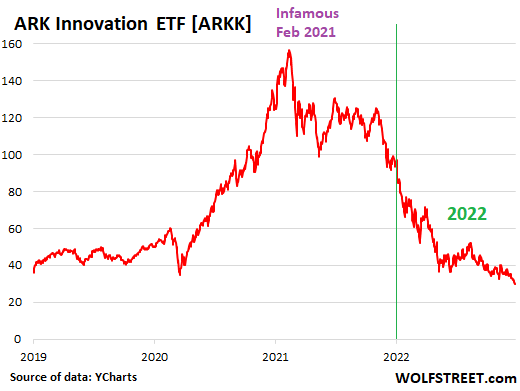
The ARK Innovation ETF also includes a few real companies that actually make money, and that have shaken up legacy industries, but whose stocks were ridiculously over-hyped-and-hoopla-ed by a crowd steeped in consensual hallucination.
The star in this group is Tesla, which accounts for over 9% of the ARK Innovation fund. It spent the year 2022 transmogrifying from an object of religious veneration to automaker and still has a long way to go to complete the transformation. Down by 70% from its peak in November 2021, Tesla was inducted in my pantheon of Imploded Stocks the day before Christmas Eve and is still in it at year-end.
Tesla is a great example of face-ripping bear market rallies that then collapsed, having completely annihilated all 2022 bear-market rallies, though the last two rallies fizzled prematurely (data via YCharts):
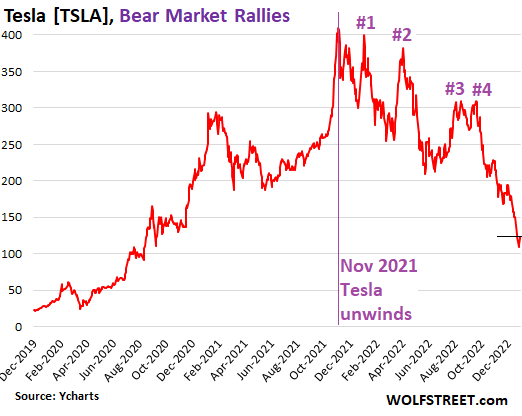
The Nasdaq is dominated by the US Tech giants. This is how much their stocks have plunged from their respective highs, and the date of the high:
| “Tech” Giants | $ Today | % From High | Date of High | |
| Apple | [AAPL] | 129.93 | -29.0% | 04-Jan-22 |
| Microsoft | [MSFT] | 239.82 | -31.4% | 22-Nov-21 |
| Alphabet | [GOOG] | 88.73 | -41.7% | 07-Nov-21 |
| Amazon | [AMZN] | 84.00 | -55.5% | 13-Jul-21 |
| Nvidia | [NVDA] | 146.14 | -57.8% | 22-Nov-21 |
| Tesla | [TSLA] | 123.18 | -70.3% | 04-Nov-21 |
| Meta | [META] | 120.34 | -68.7% | 01-Sep-21 |
The Nasdaq Composite shows the classic pattern of face-ripping bear-market rallies that then collapse. On December 28, it closed at 10,213, the lowest close since June 2020, having successfully crushed all bear-market rallies in 2022.
Today, after a 100-point jump in the last hour of trading when everyone else had already left for the holidays, it closed at 10,446, still in the red, back where it had first been in June 2020, and down 35.4% from its high 13.5 months ago in November 2021.
By comparison, during the Dotcom Bust, the Nasdaq plunged 78% over a two-and-a-half-year rollercoaster from heck – more on that in a moment. It isn’t even halfway there yet (data via YCharts):
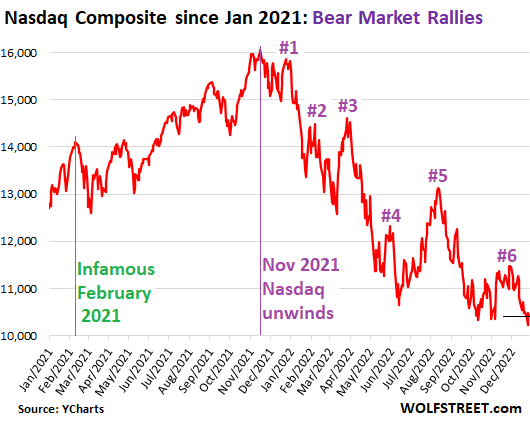
The S&P 500 Index also followed the classic pattern of face-ripping bear-market rallies in 2022 that then got crushed. It closed today at 3,839, down 19.4% from a year ago, down 20.3% from its high on January 3, 2022, and back where it had first been in January 2021. But it hasn’t yet completely crushed the bear-market rally #5 in 2022 (data via YCharts):
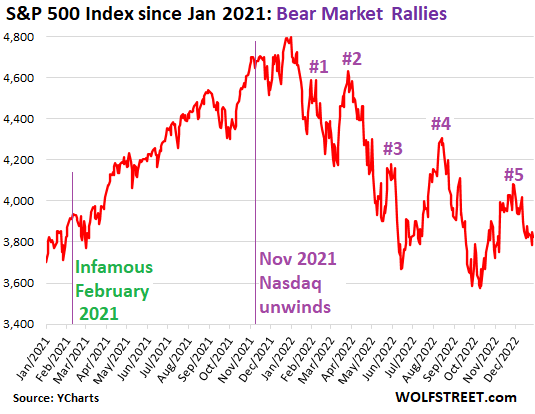
For your amusement, a comparison to the Dotcom Bust.
The final paroxysm of the Dotcom Bubble ended on March 10, 2000, when the Nasdaq peaked at 5,048. Then followed a series of declines, interrupted by bear-market rallies. This rollercoaster from heck lasted until early October 2002, when the Nasdaq bottomed out at 1,114, down 78% from the closing high.
Today’s Nasdaq is 13.5 months into the selloff, and is down 35%. During the Dotcom Bust, after 13.5 months, the Nasdaq was down 66% and in the early stages of another 35% two-month face-ripping bear-market rally that then brutally collapsed again.
History doesn’t repeat, but it rhymes, as they say.
It took 15 years, trillions of dollars of money-printing, and years of interest-rate repression before the Nasdaq, in May 2015, got back to its March 2000 high. That is not astounding. Lots of stocks just vanished. And many of the survivors — such as Intel, Cisco, MicroStrategy, et al. — never again got close their 2000 highs. And that’s not astounding either.
What is astounding is that the Nasdaq more than tripled in the 6.5 years between May 2015 and its peak in November 2021. This was a huge huge huge move, a ridiculous move, that has started to get unwound.
For your amusement — it sure wasn’t funny at the time, I swear! — here is a chart of the final phase of the Dotcom Bubble and the entire Dotcom Bust in all its glory (data via YCharts):
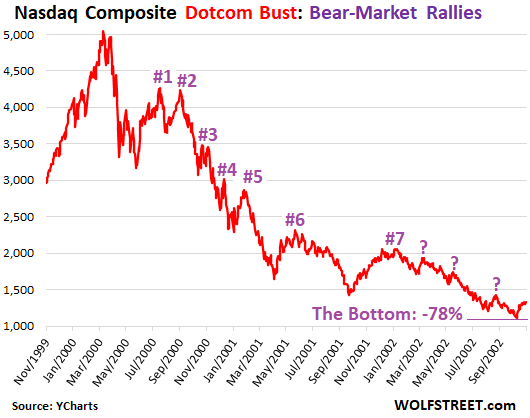
STAY INFORMED! Receive our Weekly Recap of thought provoking articles, podcasts, and radio delivered to your inbox for FREE! Sign up here for the HoweStreet.com Weekly Recap.
Wolf Richter December 31st, 2022
Posted In: Wolf Street











